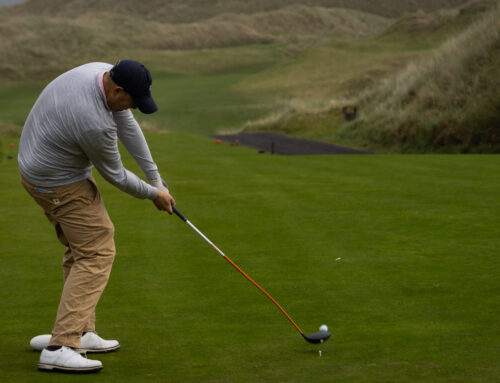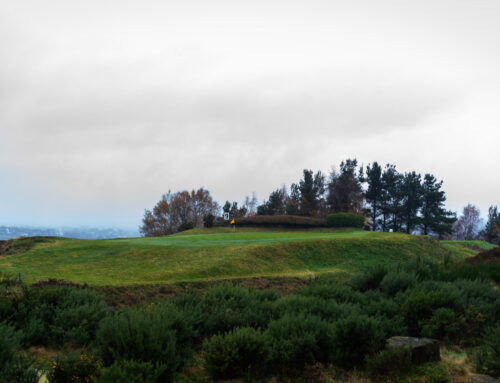As part of the recent development work at Les Bordes under the stewardship of the Private Equity group RoundShield who acquired the estate in 2018, a second 18 has been built on the higher sandy ground nearer the entrance to the 1,400 acre estate (the second largest privately owned estate in France… the largest being Disneyland in Paris). Gil Hanse was commissioned to design and layout the course with one simple brief;
‘This is a members club, a second club for almost everyone and as such it was important to create a course which was walkable and enjoyed short transitions between holes’
In contrast to The Old which is verdant and watered, The New sits on firm sandy soil, rich in fescue with the occasional smattering of heather. This is a course built with the charm of the Surrey/Berkshire heathlands and the fast running Carolina’s in mind, taking some of the features often used by the golden age greats of Abercromby, Colt, Simpson, Fowler & Ross and giving it a 21st century twist with funky green sites and some familiar Gil Hanse shaping.

The green on the 9th of the New Course at Les Bordes
Director of Golf – Jack Laws – was quick to remind us of how much room Gil was given to work with. More often than not an architect will be restricted by the proprietors keenness to add their own touches; a simple finishing hole for example, a par 3 ‘just like the one they made a hole-in-one on a buddies trip‘, or an absence of bunkering on the right side of the fairway because the owner cannot cure their slice.
Instead, at Les Bordes, Hanse was given the freedom to build and create what he saw as the best routing, and what was built and opened for play last year is a course which spends the front nine in the relative open ground, before crossing the ancient priory building and a quick stop at the halfway house to begin the back nine which enters the deep forest where the sound of club on ball reverberating off the trees is deafening.
The course is engaging, an easy walk and somewhere tempting you to try something creative. In the same way The Old seems to capture your inner child – sat there in science classes designing golf holes on the back of your notebook that would test the best ball strikers on the planet – The New conjures up a childlike mentality on the course, encouraging creativity and daring you to experiment, whether that’s aiming for a kicker or small slope around the green to feed the ball in off, or a certain shot shape to maximise the runout off the tee.
Where The Old offers a fairly binary choice of options, usually a ‘lay-up’ and a ‘go for it’ route, The New Course is one where you sit there with a drink after the round thinking about trying something different next time, or taking a bit less off the corner. Somewhere where your strategy on any given day might change, dictating a different club or shot selection, and where your decision making is as (if not more) important as its execution. It’s a nuanced course with many routes to the hole perhaps most epitomised by the short par 4 9th and 15th holes.

The shapes and contours give infinite variety.
The 9th hole has a series of flash faced bunkers and exposed sand. 280 yards from the backs, it’s a tall order to fly it all the way there and stop it, but depending on the state of the match an 8 or a 7 iron for safety might be the right call on the day. You can take it left and have a shot into the wider view of the green, or play long, right and pin high where you play across the green. Infinite variety and endless fun, where a birdie is eminently possible but trouble lurks if you try to force the issue.
Much the same could be said of the 15th which has one of the most incredible greens we’ve ever seen. Centre line bunkering, and a huge pimple protruding on the front centre of the green which races away front to back and into a trench bunker beyond. Jack Laws and course superintendent Romain seem to know that long and left is actually the best strategy here which gives you a simple eagle putt from off the green if you can wrestle the ball 280 up the left, otherwise you’ll want to be well back so you have a view of the pin and enough room to get some revolutions on the golf ball.
Its fascinating (to us at least) that the courses designed in recent years by the famous modern day greats seem to use the short par 4’s as the standout holes, whereas on The Old course and on many other contemporary designs it is the longer holes which seem to live longer in the memory (the par 5 7th & 14th being examples at The Old Course at Les Bordes). Whilst this is no doubt a case of small sample bias, it does leave us wondering about how dramatically tastes have changed in a 40 year period around golf course design.
Before 1900, many courses were set out with hazards demanding the player to flight the ball in the air. Failure to do so would usually mean the shot would be caught in a cross bunker or some form of hazard designed to punish the weaker player, and many of those courses moved away from that principle with the help of the likes of Simpson, Colt and Mackenzie reimagining the strategy of the holes and changing the way hazards were presented. In that period between 1880 and 1920 the thinking about golf course design moved dramatically, however post WWII the pendulum once again swung back towards a more penal school or architecture. Whilst we might look back at those architects form 100 years ago with rose tinted spectacles, it certainly hasn’t always been this way.
For an outstanding 5 minute recantation of the history of golf course architecture, our cookie crumbs episode with Mike Clayton is beautifully told (no surprises when the vast majority of what Clayts says is sheer gold) and talks about how golf shifted from punishing the weaker player versus rewarding the better shot.

A different perspective: Looking back down 15 above with width and mounding to underpin the strategy of the hole, whilst the below aerial shows the minimalism and restraint used by Gil and his team

15h green on The New from above
Without doubt, what is most remarkable is that Les Bordes combines every style of golf course architecture in one place, from strategic, to penal and heroic. The other famous 36 holes complexes like Sunningdale, Royal Melbourne, Winged Foot all offer two courses built with the same philosophy in mind, whereas at Les Bordes you have two completely polarising and contrasting styles of golf built only 40 years apart. A stark reminder of just how much the thinking of golf course design has changed in that time… The author of this article was born in 1986 when The Old was first opened for play. ‘An unlimited budget and timescale’ which Von Hagge easily exceeded, and in the 36 years the idea about what makes for a great course has seen a new course built in complete opposition to those ideals. Building on the most sustainable land, encouraging the use of the ground rather than an aerial approach, a less manicured aesthetic and making it playable for all standards of golfer are concepts which were frankly alien when The Old course was being constructed.
The New course is an enchanting layout, exhilarating from start to finish and certainly a course where the scorecard will flatter your golf far more than The Old ever can. Whether another course will be built in 40 years and what the principles that surround those developments time will only tell, but it certainly makes you wonder.






